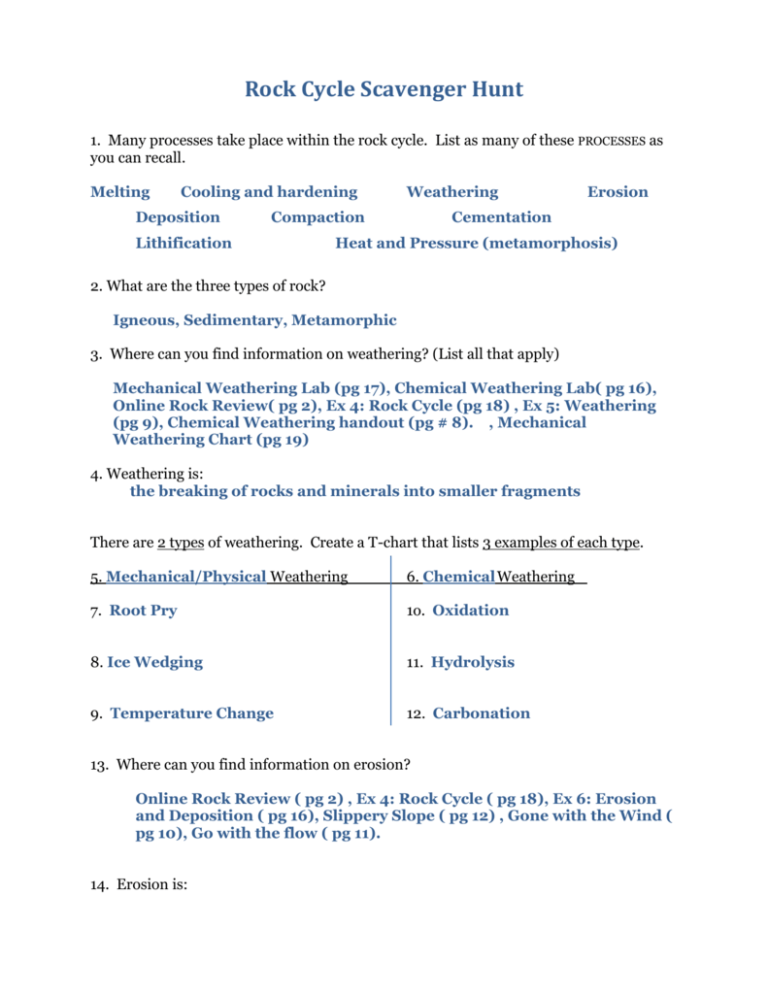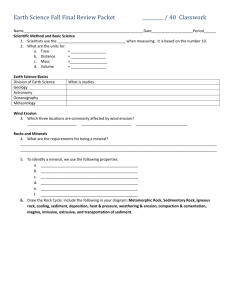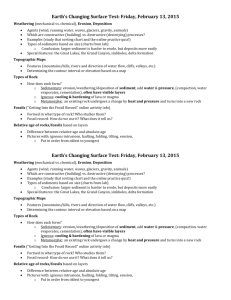Rock Cycle Scavenger Hunt
advertisement

Rock Cycle Scavenger Hunt 1. Many processes take place within the rock cycle. List as many of these PROCESSES as you can recall. Melting Cooling and hardening Deposition Weathering Compaction Lithification Erosion Cementation Heat and Pressure (metamorphosis) 2. What are the three types of rock? Igneous, Sedimentary, Metamorphic 3. Where can you find information on weathering? (List all that apply) Mechanical Weathering Lab (pg 17), Chemical Weathering Lab( pg 16), Online Rock Review( pg 2), Ex 4: Rock Cycle (pg 18) , Ex 5: Weathering (pg 9), Chemical Weathering handout (pg # 8). , Mechanical Weathering Chart (pg 19) 4. Weathering is: the breaking of rocks and minerals into smaller fragments There are 2 types of weathering. Create a T-chart that lists 3 examples of each type. 5. Mechanical/Physical Weathering 6. Chemical Weathering 7. Root Pry 1o. Oxidation 8. Ice Wedging 11. Hydrolysis 9. Temperature Change 12. Carbonation 13. Where can you find information on erosion? Online Rock Review ( pg 2) , Ex 4: Rock Cycle ( pg 18), Ex 6: Erosion and Deposition ( pg 16), Slippery Slope ( pg 12) , Gone with the Wind ( pg 10), Go with the flow ( pg 11). 14. Erosion is: Rock Cycle Scavenger Hunt Process of removing and moving sediment from one place to another 15. List four ‘agents of erosion’. Then give a specific example of each. a. water – flowing river, ocean waves b. wind – dust storm c. gravity – loosened sediment is pulled down slope of a mountain d. ice – glaciers move large rocks and boulders 16. Describe how an igneous rock might become a sedimentary rock. An igneous rock breaks down through WEATHERING and becomes sediment. The sediment is eroded downhill by gravity and then carried by a river. Next, the SEDIMENT is DEPOSITED on the side of the river. Over time more sediment is deposited on top of the sediment causing it to be COMPACTED and CEMENTED; sedimentary rock is formed. 17. Compare and contrast an igneous intrusive rock and an igneous extrusive rock. Give an example of each. Granite and Basalt are igneous intrusive rocks formed from magma deep inside the earth. Obsidian is igneous extrusive rock that forms from lava on the surface of the earth. 18. How are layers in a sedimentary rock like rings in a tree? How are they different? Layers of sedimentary rock are like rings in a tree. Each layer forms one at a time with the oldest inside and the youngest on the outside (surface). Trees are living and rocks are not. Rock Cycle Scavenger Hunt 19. Do all rocks weather at the same rate? What factors affect how fast or slow a rock will break down? Climate (moisture), surface area and pollution will all speed up the rate that rocks weather. Also, the composition of a rock will play a part since rocks made of the mineral quarts will weather slowly and feldspar weathers quickly.







